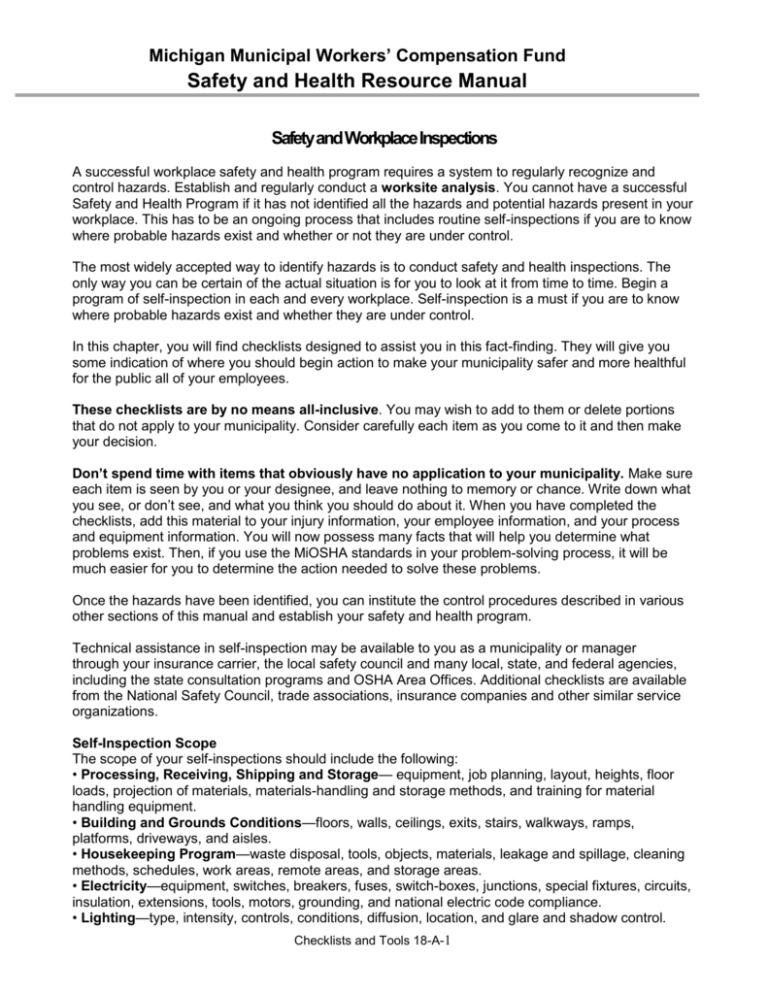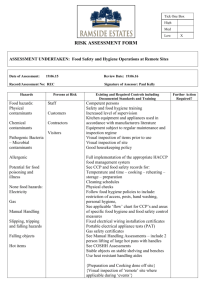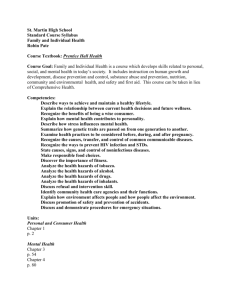Safety and Workplace Inspections
advertisement

Michigan Municipal Workers’ Compensation Fund Safety and Health Resource Manual Safety and Workplace Inspections A successful workplace safety and health program requires a system to regularly recognize and control hazards. Establish and regularly conduct a worksite analysis. You cannot have a successful Safety and Health Program if it has not identified all the hazards and potential hazards present in your workplace. This has to be an ongoing process that includes routine self-inspections if you are to know where probable hazards exist and whether or not they are under control. The most widely accepted way to identify hazards is to conduct safety and health inspections. The only way you can be certain of the actual situation is for you to look at it from time to time. Begin a program of self-inspection in each and every workplace. Self-inspection is a must if you are to know where probable hazards exist and whether they are under control. In this chapter, you will find checklists designed to assist you in this fact-finding. They will give you some indication of where you should begin action to make your municipality safer and more healthful for the public all of your employees. These checklists are by no means all-inclusive. You may wish to add to them or delete portions that do not apply to your municipality. Consider carefully each item as you come to it and then make your decision. Don’t spend time with items that obviously have no application to your municipality. Make sure each item is seen by you or your designee, and leave nothing to memory or chance. Write down what you see, or don’t see, and what you think you should do about it. When you have completed the checklists, add this material to your injury information, your employee information, and your process and equipment information. You will now possess many facts that will help you determine what problems exist. Then, if you use the MiOSHA standards in your problem-solving process, it will be much easier for you to determine the action needed to solve these problems. Once the hazards have been identified, you can institute the control procedures described in various other sections of this manual and establish your safety and health program. Technical assistance in self-inspection may be available to you as a municipality or manager through your insurance carrier, the local safety council and many local, state, and federal agencies, including the state consultation programs and OSHA Area Offices. Additional checklists are available from the National Safety Council, trade associations, insurance companies and other similar service organizations. Self-Inspection Scope The scope of your self-inspections should include the following: • Processing, Receiving, Shipping and Storage— equipment, job planning, layout, heights, floor loads, projection of materials, materials-handling and storage methods, and training for material handling equipment. • Building and Grounds Conditions—floors, walls, ceilings, exits, stairs, walkways, ramps, platforms, driveways, and aisles. • Housekeeping Program—waste disposal, tools, objects, materials, leakage and spillage, cleaning methods, schedules, work areas, remote areas, and storage areas. • Electricity—equipment, switches, breakers, fuses, switch-boxes, junctions, special fixtures, circuits, insulation, extensions, tools, motors, grounding, and national electric code compliance. • Lighting—type, intensity, controls, conditions, diffusion, location, and glare and shadow control. Checklists and Tools 18-A-1 Michigan Municipal Workers’ Compensation Fund Safety and Health Resource Manual • Heating and Ventilation—type, effectiveness, temperature, humidity, controls, and natural and artificial ventilation and exhaust. • Machinery—points of operation, flywheels, gears, shafts, pulleys, key ways, belts, couplings, sprockets, chains, frames, controls, lighting for tools and equipment, brakes, exhausting, feeding, oiling, adjusting, maintenance, lockout/tagout, grounding, work space, location, and purchasing standards. • Personnel—experience training, including hazard identification training; methods of checking machines before use; type of clothing; personal protective equipment; use of guards; tool storage; work practices; and methods of cleaning, oiling, or adjusting machinery. • Hand and Power Tools—purchasing standards, inspection, storage, repair, types, maintenance, grounding, use, and handling. • Chemicals—storage, handling, transportation, spills, disposals, amounts used, labeling, toxicity or other harmful effects, warning signs, supervision, training, protective clothing and equipment, and hazard communication requirements. • Fire Prevention—extinguishers, alarms, sprinklers, smoking rules, exits, personnel assigned, separation of flammable materials and dangerous operations, explosive-proof fixtures in hazardous locations, and waste disposal. • Maintenance, including tracking and abatement of preventive and regular maintenance— regularity, effectiveness, training of personnel, materials and equipment used, records maintained, method of locking out machinery, and general methods. • Personal Protective Equipment—type, size maintenance, repair, storage, assignment of responsibility, purchasing methods, standards observed, training in care and use, rules of use, and method of assignment. • Transportation—motor vehicle safety, seat belts, vehicle maintenance, and safe driver programs. • Review—evacuation routes, equipment, and personal protective equipment. INSPECTIONS GUIDE POSTS Wear and tear, use, and misuse eventually will affect the operating condition of your facility, equipment and machinery. For the safety and health of employees and others visiting your work areas, it is important to identify potential losses and then control or eliminate them. Regular, planned inspections of your total business environment are essential in view of your legal and moral obligation to provide for the safety of employees and the public. Using the guidelines that follow will help you to: 1. Maintain a safe work environment 2. Control the unsafe actions of people 3. Affirm product quality 4. Uphold operational profitability GUIDLELINES 1. Plan the inspection. Become familiar with the areas that need inspection and the hazards common to each area. Using a common hazards checklist can help to increase the effectiveness and productivity of the inspection by providing an outline of items to be inspected. A sample list of common hazards accompanies this document. 2. Be systematic and complete. Once you determine the areas requiring inspection, look at everything in each area, including those in out-of-the-way places that are rarely visited. Give first Checklists and Tools 18-A-2 Michigan Municipal Workers’ Compensation Fund Safety and Health Resource Manual priority to items that can become unsafe or cause losses if not inspected regularly or that the government regulates or. 3. Record the results of the inspection, particularly any unsafe practices and conditions you find. The report can be in any format but should allow for complete and accurate documentation. This is essential for future reference from both a legal and loss control standpoint. 4. Take corrective action promptly. When permanent measures are not feasible at once, temporary measures may be undertaken to avert further immediate danger. 5. Follow up to assure that your corrective action has permanently eliminated or controlled the basic cause of each unsafe practice or condition. 6. Special exposure in the areas of fire protection, environmental health, products, etc., have unique features and loss potentials that may require a more specialized inspection. Consider obtaining additional training in these areas to improve your ability to conduct an adequate inspection. Checklists and Tools 18-A-3 Michigan Municipal Workers’ Compensation Fund Safety and Health Resource Manual EXAMPLES OF COMMON HAZARDS Housekeeping And Sanitation: A. Excess accumulation of waste and trash B. Blocked and inadequate aisles C. Improperly discharged dusts, vapors, etc. D. Potable water not provided E. Non-potable water not clearly marked F. Disorderly storage and supply rooms G. Inadequate or dirty lavatory facilities Tools And Equipment: A. Improper grounding and unsatisfactory wiring B. Mechanical safeguards not in use C. Tool not used for intended job D. Lack of proper maintenance Fire Protection: A. Insufficient number or type of extinguishers B. Improper storage of flammables C. Disregard for “No Smoking” regulations D. Fire department phone number unavailable E. Extinguishers not tagged or location marked Motorized Vehicles: A. Faulty parking and foot brakes B. Inoperative or faulty gauges or lights C. Tires bald, flat or improperly inflated D. Defective windshield wiper, defroster or windshield Personal And Protective Equipment: A. Equipment not in use where required B. Insufficient equipment for the exposure C. Equipment not maintained properly Material Handling And Storage: A. Lifting being done incorrectly B. Material unprotected from weather conditions C. Improper stacking, storing or labeling D. Floor load limits not posted E. Slings, forklifts, skids, etc. defective Walking - Working Surfaces: A. Aisles not marked or kept clear B. Unprotected openings C. Guardrails and toeboards substandard D. Slippery, uneven or potholed surfaces Exits: A. B. C. D. E. Missing or inadequate “Exit” signs Sticking, binding or inoperative doors Exit route or doors obstructed Panic hardware missing or inoperative Lack of sufficient emergency exits Policy Statement Representatives from each department should conduct quarterly safety inspections of their work areas. They document their findings and the steps that the department will take to correct any deficiencies. Each work area has a checklist that specifically identifies the hazards in it. Audit forms and completed action plans are on file and available for inspection. Note: Identified inspection deficiencies requiring immediate attention or repair are given priority and corrected as soon as possible. Checklists and Tools 18-A-4





